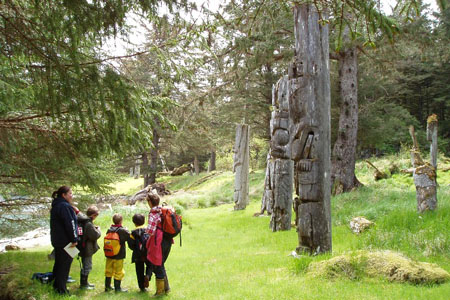Browse "National historic sites"
-
Article
Fort St Joseph National Historic Site of Canada
Fort St Joseph National Historic Site, near Sault Ste Marie, Ont, was designated by the Historic Sites and Monuments Board of Canada in 1923 to recognize Fort St Joseph's significance as the most westerly British post and for its importance to the fur trade and to the alliances with First Nations.
"https://development.thecanadianencyclopedia.ca/images/tce_placeholder.jpg?v=e9dca980c9bdb3aa11e832e7ea94f5d9" // resources/views/front/categories/view.blade.php
https://development.thecanadianencyclopedia.ca/images/tce_placeholder.jpg?v=e9dca980c9bdb3aa11e832e7ea94f5d9
-
Article
Fort Carillon (Ticonderoga)
Fort Carillon was built in 1755 on the orders of the governor of New France, Pierre de Rigaud de Vaudreuil. Situated at the junction of Lake George and Lake Champlain, the fort was intended to reinforce France's military presence in an area contested by the British colonies. In 1759, Fort Carillon was abandoned by the French and renamed Fort Ticonderoga by the British. (See Seven Years’ War.)
"https://d2ttikhf7xbzbs.cloudfront.net/Fort_Ticonderoga_Ticonderoga_NY.jpg" // resources/views/front/categories/view.blade.php
https://d2ttikhf7xbzbs.cloudfront.net/Fort_Ticonderoga_Ticonderoga_NY.jpg
-
Article
Fort Toulouse and Port Toulouse
The village of Port Toulouse and its fort are situated in St. Peter's, Cape Breton, Nova Scotia.
"https://d2ttikhf7xbzbs.cloudfront.net/media/media/02cde42e-b8fa-42bb-a0c6-fcbc67f53b8a.jpg" // resources/views/front/categories/view.blade.php
https://d2ttikhf7xbzbs.cloudfront.net/media/media/02cde42e-b8fa-42bb-a0c6-fcbc67f53b8a.jpg
-
Article
Fort Vancouver
Fort Vancouver, a HUDSON'S BAY CO fur-trade post, was originally constructed in 1825 by Dr. John McLoughlin about 150 km inland on the north bank of the Columbia River, 8 km above the mouth of the Willamette. In 1829, the
"https://d2ttikhf7xbzbs.cloudfront.net/media/media/8995b1e1-60ec-48e0-8b23-d944da85cc4d.jpg" // resources/views/front/categories/view.blade.php
https://d2ttikhf7xbzbs.cloudfront.net/media/media/8995b1e1-60ec-48e0-8b23-d944da85cc4d.jpg
-
Article
Fort Victoria
In 1842, James DOUGLAS of the HUDSON'S BAY CO selected the port of Camosack (the harbour where Victoria now stands) as a new fur-trade post - eventually to replace FORT VANCOUVER as the company's Pacific headquarters and to bolster the British claim to VANCOUVER ISLAND.
"https://development.thecanadianencyclopedia.ca/images/tce_placeholder.jpg?v=e9dca980c9bdb3aa11e832e7ea94f5d9" // resources/views/front/categories/view.blade.php
https://development.thecanadianencyclopedia.ca/images/tce_placeholder.jpg?v=e9dca980c9bdb3aa11e832e7ea94f5d9
-
Article
Fort Walsh
Following the defeat of General George Custer (1876), the Mounted Police centered at Fort Walsh were called upon to mediate with refugee Sioux who had followed Chief SITTING BULL across the US border, thereby creating an international incident.
"https://d2ttikhf7xbzbs.cloudfront.net/media/media/b7bd4098-56cd-4e5e-a735-7d8ef4b040aa.jpg" // resources/views/front/categories/view.blade.php
https://d2ttikhf7xbzbs.cloudfront.net/media/media/b7bd4098-56cd-4e5e-a735-7d8ef4b040aa.jpg
-
Article
Fort Wellington National Historic Site of Canada
Fort Wellington National Historic Site, designated in 1920, was one of the first HISTORIC SITES in Canada to receive national recognition of its historical importance. The first Fort Wellington was built by the British at PRESCOTT, Ont, on the north bank of the St Lawrence River.
"https://development.thecanadianencyclopedia.ca/images/tce_placeholder.jpg?v=e9dca980c9bdb3aa11e832e7ea94f5d9" // resources/views/front/categories/view.blade.php
https://development.thecanadianencyclopedia.ca/images/tce_placeholder.jpg?v=e9dca980c9bdb3aa11e832e7ea94f5d9
-
Article
Fort Whoop-Up
Fort Whoop-Up, situated at the junction of the Belly (now Oldman) and St Mary rivers, near present-day Lethbridge, Alberta, was established in 1869 by John J. Healy and Alfred B. Hamilton of Montana.
"https://development.thecanadianencyclopedia.ca/images/tce_placeholder.jpg?v=e9dca980c9bdb3aa11e832e7ea94f5d9" // resources/views/front/categories/view.blade.php
https://development.thecanadianencyclopedia.ca/images/tce_placeholder.jpg?v=e9dca980c9bdb3aa11e832e7ea94f5d9
-
Article
Fort William
Named in 1807 after NWC chief superintendent William MCGILLIVRAY, Fort William occupied a pivotal place in the company's vast trading network. In 1816-17 Lord SELKIRK occupied Fort William for 10 months as a consequence of the SEVEN OAKS INCIDENT.
"https://d2ttikhf7xbzbs.cloudfront.net/media/media/7b13aa86-dd8f-4056-b650-3839e00b77e9.jpg" // resources/views/front/categories/view.blade.php
https://d2ttikhf7xbzbs.cloudfront.net/media/media/7b13aa86-dd8f-4056-b650-3839e00b77e9.jpg
-
Article
Fort York National Historic Site
The Fort York National Historic Site commemorates several British military installations which guarded the entrance to Toronto Harbour.
"https://d2ttikhf7xbzbs.cloudfront.net/media/media/a55f0fd3-041e-4936-ac4d-11d232bbdf0e.jpg" // resources/views/front/categories/view.blade.php
https://d2ttikhf7xbzbs.cloudfront.net/media/media/a55f0fd3-041e-4936-ac4d-11d232bbdf0e.jpg
-
Article
Gray Burial Site
Gray Burial Site, north of Swift Current, Sask, lies on a sandy hillside west of an ancient glacial outwash channel.
"https://development.thecanadianencyclopedia.ca/images/tce_placeholder.jpg?v=e9dca980c9bdb3aa11e832e7ea94f5d9" // resources/views/front/categories/view.blade.php
https://development.thecanadianencyclopedia.ca/images/tce_placeholder.jpg?v=e9dca980c9bdb3aa11e832e7ea94f5d9
-
Article
Gwaii Haanas National Park Reserve and Haida Heritage Site
Encompassing rainforests, alpine meadows and rocky shores of southern Haida Gwaii (formerly the Queen Charlotte Islands), Gwaii Haanas National Park Reserve and Haida Heritage Site (1495 km2) harbours some species of plants and animals not found anywhere else on the globe.
"https://d2ttikhf7xbzbs.cloudfront.net/media/media/1d34f43a-14db-43e0-8206-647ca92632f2.jpg" // resources/views/front/categories/view.blade.php
https://d2ttikhf7xbzbs.cloudfront.net/media/media/1d34f43a-14db-43e0-8206-647ca92632f2.jpg
-
Article
Halifax Citadel
The general introduction of rifled artillery (with greater range and accuracy than earlier guns) shortly after completion of the Citadel rendered the costly installation obsolescent. It was partially rearmed in the 1860s and 1870s, and continued in use as a barracks into the 20th century.
"https://d2ttikhf7xbzbs.cloudfront.net/media/media/2a4ab68a-776a-430a-9155-c6d6ae17697b.jpg" // resources/views/front/categories/view.blade.php
https://d2ttikhf7xbzbs.cloudfront.net/media/media/2a4ab68a-776a-430a-9155-c6d6ae17697b.jpg
-
Article
Hebron Mission National Historic Site of Canada
For generations, Hebron, one of Nunatsiavut’s (see Labrador Inuit and Newfoundland and Labrador) most culturally important and significant sites, was an important meeting place for the Inuit, as well as a primary hunting and fishing area. In the early 1800s, Moravian missionaries chose the site to establish their fourth and northernmost mission in Labrador, officially opening the mission in 1830 (although missions were later established farther north, at Ramah in 1871 and Killinek in 1905). For more than 130 years, Hebron was a thriving community where an average of 200 to 250 Inuit lived. In 1959, without consultation with the Inuit, the community was closed, forcing all Inuit to relocate. Declared a National Historic Site in 1976 by the federal government, the Hebron Mission has been undergoing major restoration since 2004.
"https://d2ttikhf7xbzbs.cloudfront.net/media/new_article_images/HebronMissionNationalHistoricSiteofCanada/Hebron_Mission_1901_photo.png" // resources/views/front/categories/view.blade.php
https://d2ttikhf7xbzbs.cloudfront.net/media/new_article_images/HebronMissionNationalHistoricSiteofCanada/Hebron_Mission_1901_photo.png
-
Article
Heritage Trail
Hundreds of trails are now found from coast to coast in Canada, installed and run by national and provincial parks, the Canadian Wildlife Service, tourist departments, conservation authorities, museums, universities, schools, botanical gardens and private agencies.
"https://development.thecanadianencyclopedia.ca/images/tce_placeholder.jpg?v=e9dca980c9bdb3aa11e832e7ea94f5d9" // resources/views/front/categories/view.blade.php
https://development.thecanadianencyclopedia.ca/images/tce_placeholder.jpg?v=e9dca980c9bdb3aa11e832e7ea94f5d9
